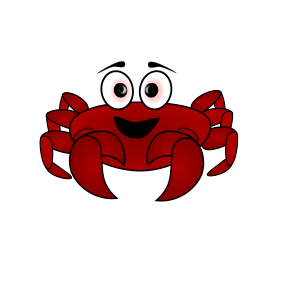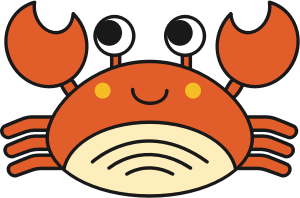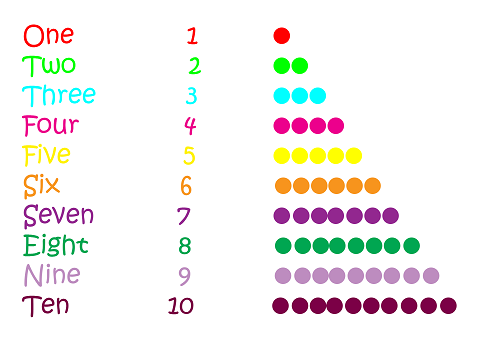Prekinder to Grade 2 Mathematics
Counting: Naming the Numbers to 100
Counting: Naming the Numbers to 100

Cuthbert the crab was crawling along the shoreline one day when he heard his friend Clarissa counting pipis as they buried themselves in the sand. He heard her saying "twenty-ten, twenty-eleven, twenty-twelve ...".
"Oh, dear!" thought Cuthbert as he scuttled up to Clarissa, "I think Clarissa needs some help with learning to count".

Clarissa certainly does seem to need a bit of help. Let's see if we can help her out with the words for the numbers from one to one hundred.
The Numbers from 1 to 10
Let's start at the beginning, and make sure Clarissa knows the words for the numbers from \(1\) to \(10\). Clarissa, just pretend that the dots in this table are pipis. The numbers and words beside the dots tell you what the word for the number is, and what the numeral looks like:

So, to count from \(1\) to \(10\), we say "one, two, three, four, five, six, seven, eight, nine, ten".
The Numbers from 11 to 20
Now, it looks like you might have made it this far, already, but let's just make sure, Clarissa. The next number after ten is eleven, then twelve, thirteen, fourteen, fifteen, sixteen, seventeen, eighteen, nineteen and twenty, just like in this table. Again, the dots are your pipis:

The word for the number, and the numeral appear above the dots. Eleven, twelve and thirteen are special cases, but the words for \(14,15,16,17,18,\) and \(19\) are just the words for \(4,5,6,7,8\) and \(9\), followed by "teen", which tells you that you need to add ten to the number you said first. So, for example, "fourteen" is "four" plus "teen", which means \(4 + 10 = 14\). Finally, "twenty" is the word for two tens.
The words for the tens
We've already met two of the words for tens: ten (one ten) and twenty (two tens). This table will help you out with the rest of them. The first line of each row shows the name of the number, the second line shows its numeral, and the third contains rows of dots (pipis) showing what you need to count to get to that number:

It's time for a little spelling lesson. Did you notice that "forty" looks a bit strange? We drop the "u" from "four" when we write "forty", even though we keep it for "four" and "fourteen". English spelling is sometimes a bit odd, isn't it?
Filling in the rest of the numbers up to one hundred
Of course, Clarissa is really interested in counting those pipis, and she doesn't want to stop at twenty. She wants to go on and on. We'll take her up to one hundred for now. We need to explain to her that she already knows everything she needs to count to one hundred.
To get from twenty to thirty, we say "twenty-one, twenty-two, twenty-three, twenty-four, twenty-five, twenty-six, twenty-seven, twenty-eight, twenty-nine, and then thirty". Did you see how we just added a dash, followed by the second digit to each word? The numerals we just named are "21,22,23,24,25,26,27,28,29,30". "Thirty", of course, is the word for three tens. We repeat the same pattern for "thirty-one, thirty-two" and so on, all the way up to "forty". Next comes "forty-one, forty-two, etc.," up to "fifty", then "fifty-one, fifty-two, fifty-three", and so on. We do the same for the sixties, seventies, eighties and nineties. Finally, after "ninety-nine" comes "one hundred", which has the numeral \(100\). That's all there is to it!
There seem to be a lot of numbers, but we really only have to learn the numbers from one to twenty, then the names for the tens up to one hundred.
Ok then, Clarissa, you can go off and count your pipis now. Cuthbert smiles as he listens to her saying "...twenty-nine, thirty, thirty-one, thirty-two ...". It sounds like a job well done.
Description
This mini book covers the core of Math for Foundation, Grade 1 and Grade 2 mathematics including
- Numbers
- Addition
- Subtraction
- Division
- Algebra
- Geometry
- Data
- Estimation
- Probability/Chance
- Measurement
- Time
- Money
- and much more
This material is provided free of cost for Parent looking for some tricks for their Prekinder, Kinder, Prep, Year 1 and Year 2 children
Audience
Grade 1/Year 1, Grade 2/Year 2, Prep, Foundation, Kinder and Pre-Kinder
Learning Objectives
These lessons are for kids aged 4-8 with the core objective to expose their brains to concepts of addition, subtraction, division, algebra and much more.
Author: Subject Coach
Added on: 6th Apr 2018
You must be logged in as Student to ask a Question.
None just yet!